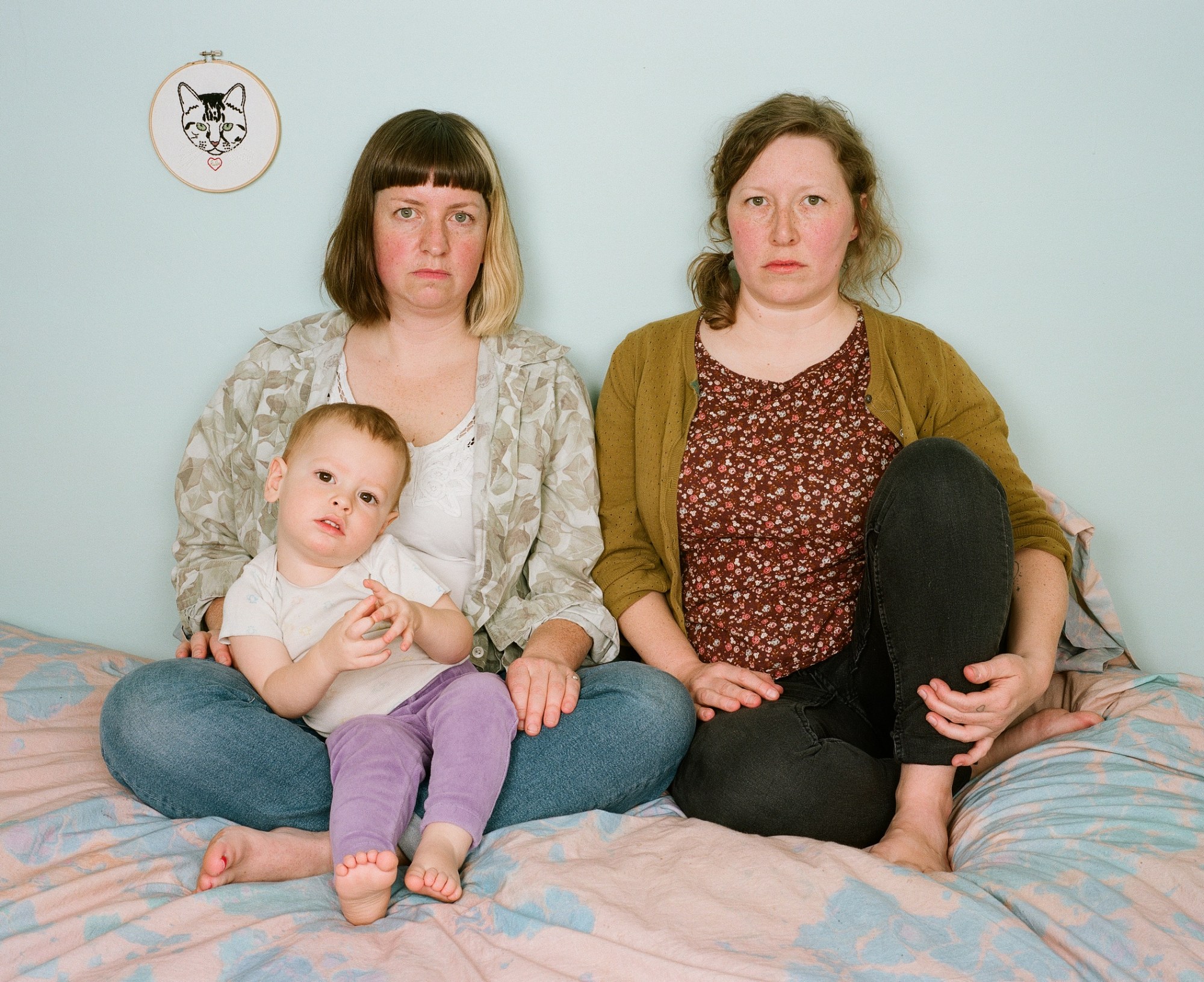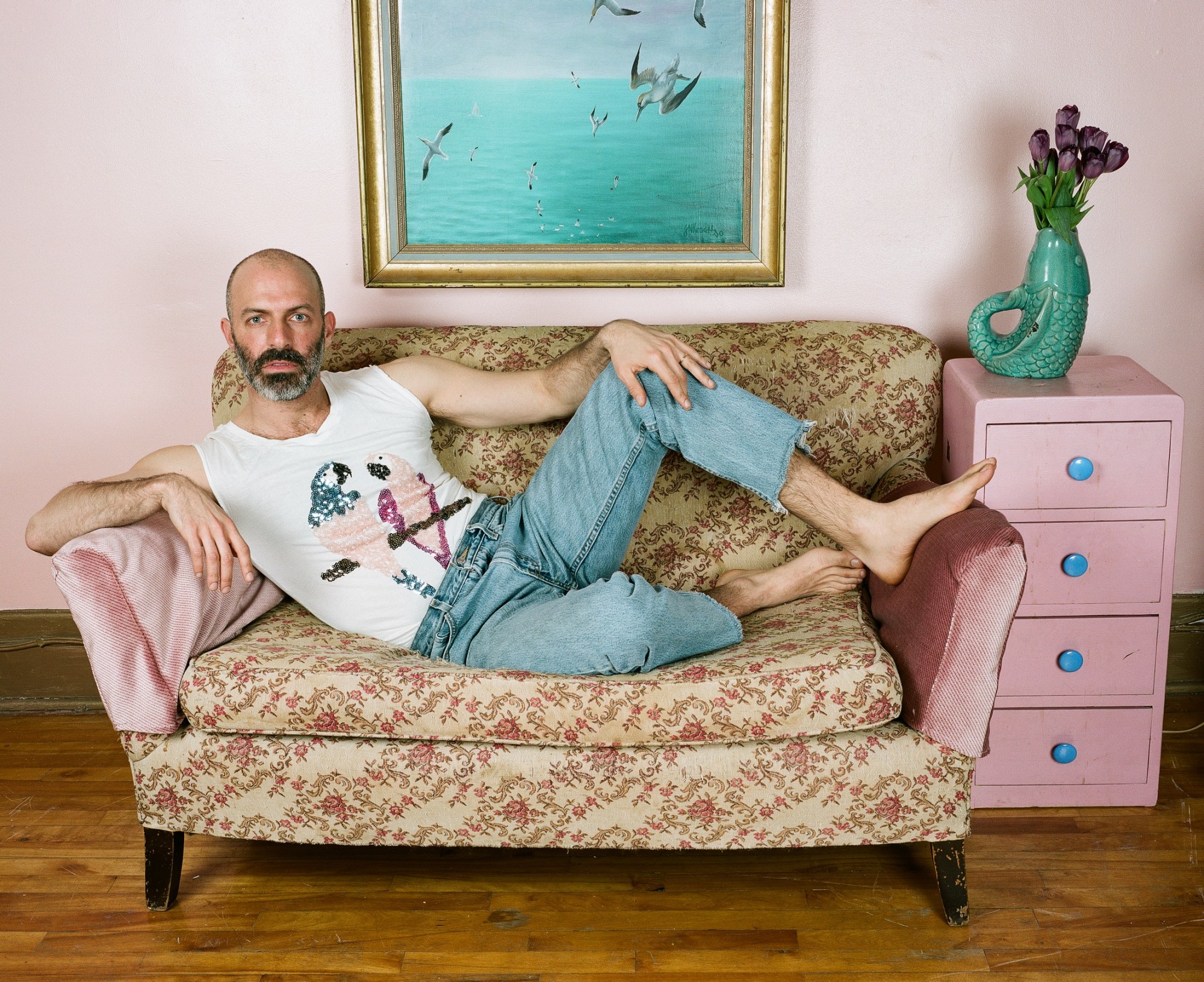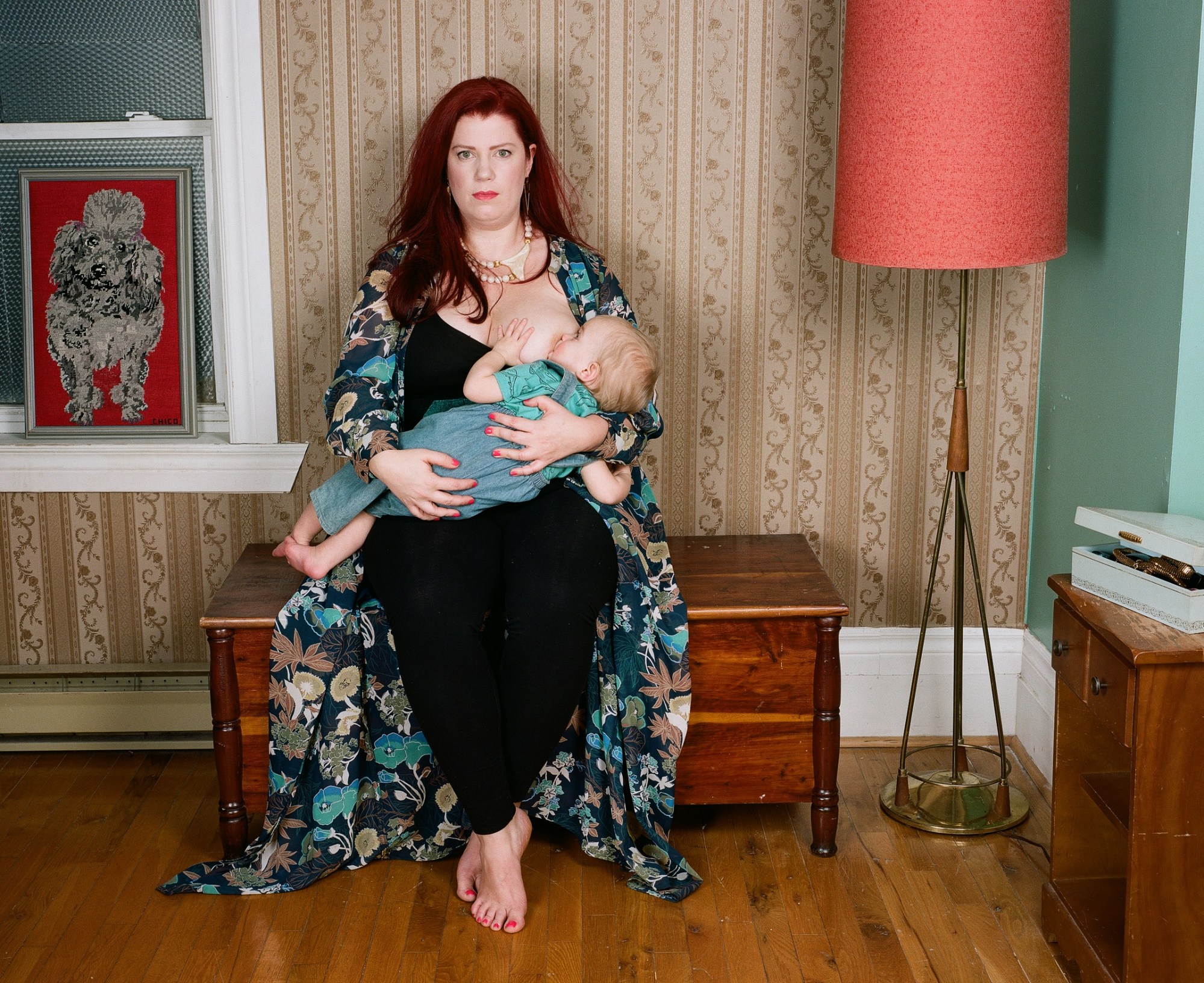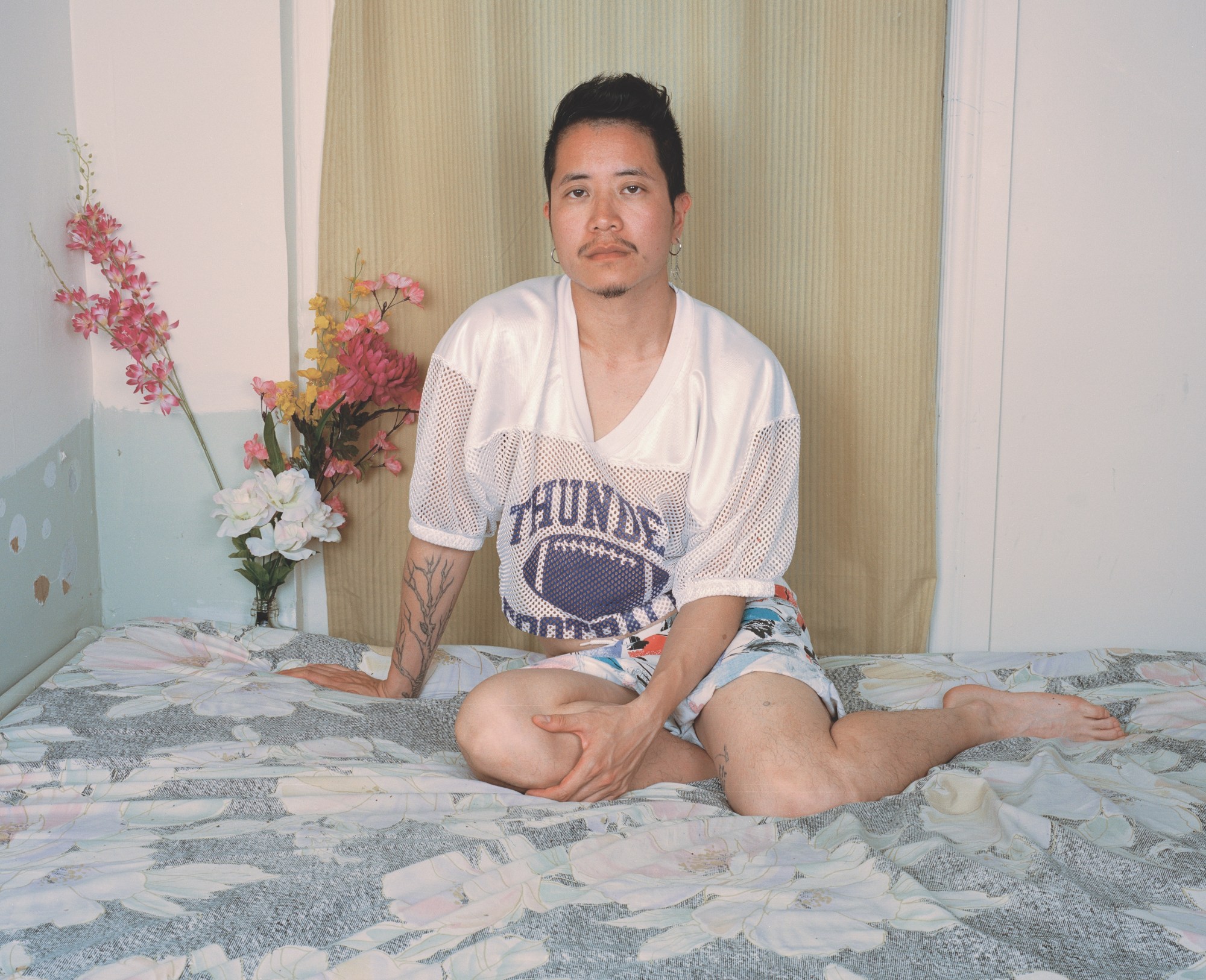JJ Levine has spent a decade photographing the Montreal queer community and exploring gender fluidity. In his diptych series “Switch,” he posed gay couples in strategic outfits, wigs, and makeup, to express one gender—and then the reverse—both depictions equally convincingly. In “Alone Time,” the concept was funneled further, with one model believably embodying both genders within a single frame—again flummoxing the fixity of the binary. Both series cleverly underscore the performative nature of gender, and how readily and naturally it can be dismantled. Levine wants trans, gender-queer, and non-binary people to see their experience represented in his work—and for straight, cis people to revisit (and deconstruct) assumptions about gender and bodies.
Levine’s latest series is more plainspoken than his earlier work, situating LGBTQ identities in the tradition of intimate and composed portraiture. He highlights not only interpersonal bonds but the private space in which comfort and security is carved out. As his friends hit their 30s, Levine has been cataloguing the formation of young families. The construct has reshaped itself rather radically around new permutations of coupledom and parenthood. The series celebrates this new alternative with a totally even keel, making it clear through his approach that it’s no different than documenting the longstanding heteronormative legacy.

“Family” (on view through Sept 22 at the Rencontres d’Arles photography festival in the south of France) is shown amongst ten finalists for the Louis Roederer Discovery Award for emerging photographers. i-D spoke to Levine about prizing aesthetics as much as identity politics, the pantheon of queer figures he respects, and the thrill of the cultural conversation catching up to his work.
How did you initially decide to become a photographer?
When I was much younger, I attended a retrospective exhibit of Nan Goldin’s work at the Musée d’art contemporaine in Montreal and it had a profound impact on me. It wasn’t until years later when I was in art school that I began to explore the medium myself in a serious way.
You’ve been spotlighting queer identity for many years. As conversations around this topic become more prevalent and widespread outside the queer community, does that alter anything in your approach as a photographer? Has it changed how an audience engages with your images in any way?
It hasn’t necessarily changed how I make images, but it has been fascinating to see work that I made 10 years ago finally gain recognition as mainstream culture has begun to expand to include queer issues and realities. The reception of my work has radically changed over the course of my relatively short career.
Your previous series “Switch” and “Alone Time” are about “separating sexuality from gender and identity from anatomy,” as you once put it in an interview . Did you anticipate this evolution from individuals and couples into family—is this part of a larger developmental arc, in a way? Or is this latest work simply an offshoot of “ Queer Portraits”?
I consider “Family” and “Intimates” to be the most recent iterations of my broader “Queer Portraits” series. All of my work to date deals with themes around gender, sexuality, and identity, though my various projects do so by employing different strategies. “Alone Time” and “Switch” address these issues using masquerade and optical illusion, drawing on the idea of the uncanny, whereas my more straightforward portrait series can disarm the viewer on an emotional level.

Does Montreal feel significant as a locus for your series?
Montreal is a unique place on many levels, but there are socio-economic reasons why community can exist in a different way here than in other, more expensive cities of a similar size. The relatively low cost of living in Montreal is also a major contributing factor to the thriving arts and culture scene here. The aesthetics that I am drawn to and surrounded by often reference different eras—I haven’t encountered this to the same extent in most other cities I’ve visited. More importantly though, the people I photograph are those I share my life with; we intentionally live in close proximity to one another.
“Family” is on view in France right now, where there is systemic homophobia pertaining to gay families (regarding both medical and legal policies). Do you see your work as a means not just of sparking conversation but underpinned by activism?
On the one hand, yes, I see my work as unapologetically political, but on the other hand, when I’m shooting, I never think of my subject matter as some kind of crusade for LGBTQ rights. I’m not making a pamphlet to further an agenda; I am making images of my life and the lives and identities of the people whom I love. My images are highly personal, even quotidian, so when I’m making them I’m thinking more on that level. When I take a step back, though, I am able to embrace the idea that they have the potential to be politically engaging. In an ideal world, they would expand other people’s understanding of and compassion toward my community.
You photograph people you have a strong interpersonal relationship with. What is your conversation like around a shoot?
I normally broach the topic with the person I want to photograph weeks or even months in advance. A lot of planning goes into each shoot, from location to decor and furniture to what the person will be wearing in their portrait. Each object has been carefully selected and has been discussed beforehand. A tube of lipstick or a pill bottle on a bedside table is there for a reason. I try to create an image that works well on its own on a formal level but is also connected to my other photographs through palette and pattern or motif. However, I am not thinking exclusively about these formal concerns; I also try to include clues about the person I’m photographing. For “Switch” and “Alone Time,” I’m generally the one who provides all the costumes and wardrobe, whereas in “Queer Portraits,” I usually ask the person to show me a broad selection of their own garments that they feel comfortable and confident in.

Which contemporary cultural icons do you think are opening up the conversation around queer identity and/or queer families in a meaningful way?
There are many trans women in pop culture who have been opening up conversations around identity over the past decade, such as Laverne Cox and Janet Mock. Kai Cheng Thom is a young writer whose debut novel, Fierce Femmes and Notorious Liars, published by Metonymy Press, has recently gained international recognition via Emma Watson’s book club. Thom has been expanding conversations about how to find and maintain community and love in a world that is designed to destroy queer and trans people, and especially trans women of color.
I really appreciate that the photography of A.L. Steiner and Catherine Opie exposes queer parenthood outside of mainstream gay sexuality through two very different image-making practices. Maggie Nelson’s writing so eloquently fuses baby making, queer identity, and art theory.
As controversial as the show Transparent has been, I have never before seen multiple characters within one family grappling with queer and trans identity onscreen—and certainly not in such a nuanced way.
Which other photographers—or other kinds of creatives, if more applicable—do you admire? I’ve always loved self-portraiture, though I rarely photograph myself. I’m really excited about the work of Zanele Muholi, Mari Katayama, Pixy Liao, and Martine Gutierrez. I recently had the pleasure of discovering the portrait photography of John Edmonds, Malika Mihoubi & Loïc Xavier, Seydou Keïta, Tomasz Machciński, Tom Wood, and Neil Kenlock.
[In terms of other creatives] I would say that I draw much of my inspiration from film aesthetics. On a visual level, I really appreciate the oeuvre of Pedro Almodóvar, Luca Guadagnino’s Call Me by Your Name as well as Léa Pool’s 1999 film Emporte-moi, to name just a few. These films are not just queer narratives but—equally importantly for me—use lush colors and textures.

What are you working on next?
In the past several years, I have begun to include moving images in my practice: mostly 16mm, some Super 8 as well. I plan to continue exploring this medium. As many of my series are ongoing, I am always shooting new portraits of people in my life—I am making new “Alone Time” images, and one day I hope to make them into a book.
